| TiO2 (Rutile) - in stock! | |
| Model | Product Name+ | Buy Now |
| P-TiO2-10-10-8 | Rutile (TiO2) coupling prism, 10x10x8 mm |
|
| P-TiO2-5-5-5 | Rutile (TiO2) coupling prism, 5x5x5 mm |
|
Del Mar Photonics - Newsletter
Rutile (TiO2) coupling prisms and their applications - buy online - download brochure
Del Mar Photonics offers optical elements made of high quality synthetically
grown Rutile Titanium Dioxide crystals. Rutile’s strong birefringency, wide
transmission range and good mechanical properties make it suitable for
fabrication of polarizing cubes, prisms and optical isolators. Boules having
high optical transmission and homogeneity are grown by proprietary method.
Typical boules have 10 - 15 mm in dia. and up to 25 mm length. Optical elements
sizes - from 2 x 2 x 1 mm to 12.7 x 12.7 x 12.7 mm. Laser grade polish quality
is available for finished elements. So far we the largest elements that we
manufactured are
12 x15 x 5 mm, in which optical axis is parallel to 15 mm edge, 5 mm is
along
beam path, 12 x 15 mm faces polished 20/10 S/D, one wave flatness,
parallelism < 3 arc.min. (better specs. available on request).
|
|||||||||
|
|
|||||||||
|
|||||||||
|
||||||||||||||||||||||||||||||
|
| Standard Specifications (buy
online): Rutile (TiO2) coupling prism |
 |
Research description for a Rutile coupling prism
This description will give a brief insight into our research at the
Light Technology Institute of the University of Karlsruhe (TH), Germany. One of
our research fields is the development of electrically pumped organic
semiconductor thin film lasers. Due to the complex behavior of these lasers
numerous electrical and optical characterization is necessary. One of the most
important optical properties of these organic semiconductor laser structures is
the attenuation coefficient of the multilayer waveguide, which has to be
carefully optimized to reduce waveguide losses 1. The first step in the
optimization process is the numerical simulation of the anticipated waveguide
design. Next, the optimized sample structure is fabricated and characterized in
our attenuation measurement setup. This measurement is done as follows:
A Rutile coupling prism is pressed onto the waveguide. A laser beam is then
coupled into the prism so that total reflection occurs inside the prism at the
interface to the waveguide. In the vicinity of the waveguide the overlapping
incident and reflected beam generate a standing wave. The evanescent field of
that standing wave penetrates into the waveguide.
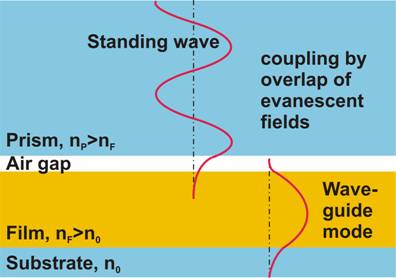
Evanescent field coupling
Under a certain angle and if the phase match conditions are fulfilled, the
evanescent field stimulates a mode that is guided by the waveguide. The phase
match condition can only be achieved when the refractive index of the prism is
at least as high as the effective refractive index of the waveguide. Owing to
its high refractive index, Rutile is an ideal material for use as a coupling
prism in such a prism-coupler waveguide attenuation measurement setup.

Beam coupling into waveguide
A small fraction of the guided light is scattered out of the waveguide. The
intensity of this scattered light is assumed to be proportional to the intensity
of the guided light. Thus the intensity distribution inside the waveguide along
the propagation direction can be directly determined through measuring the
intensity of the scattered light.
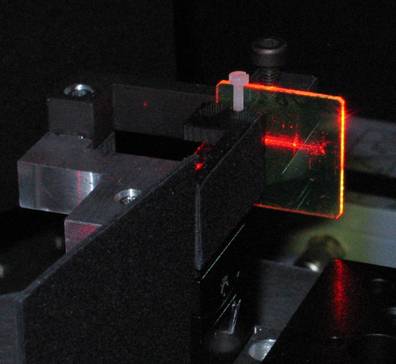
Streak caused by scattering inside the waveguide
The intensity distribution is detected with a computer controlled, cooled CCD-Camera.
Finally the attenuation coefficient is extracted from the measured data.
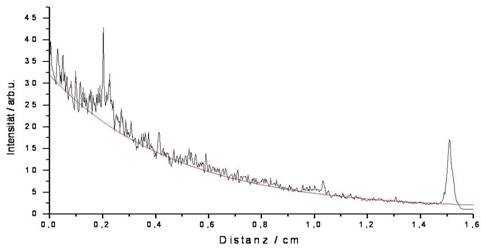
Intensity distribution measured with CCD-Camera
The following two figures show the setup that was used for the measurements.
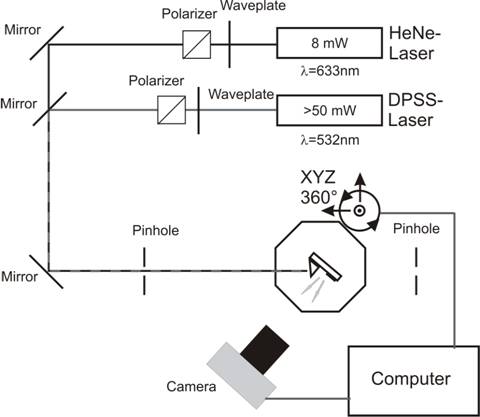
Schematic of the Setup

Photography of the Setup
Additionally, it is possible with our setup to measure the refractive index and
the thickness of waveguides that support a minimum of two guided modes. These
parameters can be extracted from the dependency between coupling angle and
effective refractive index.
Keywords: Prism, Coupling, Thin film waveguide, Waveguide losses, scattering,
Effective refractive index, Organic semiconductor lasers, Polymer, Small
molecule, Evanescent field, CCD-Camera, Coupling angle
1 M. Reufer, J. Feldmann, P. Rudati, A. Ruhl, D. Müller, K. Meerholz, C.
Karnutsch, M. Gerken, and U. Lemmer, Appl. Phys. Lett. 86, 221102 (2005).
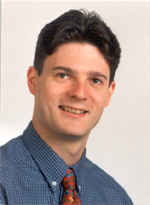 |
MSc.Christian Karnutsch Lichttechnisches Institut Universität Karlsruhe (TH) Geb. 30.34 Kaiserstraße 12 D-76131 Karlsruhe Raum: 126 Telefon: +49 721 608 7742 Telefax: +49 (0)721 608 - 2590 |
Del Mar Photonics - Rutile prisms from online store - Rutile properties (including refractive index)
Examples of research done or proposed to be done using rutile coupling prisms - request a quote
Nonlinear Optics in Whispering Gallery Mode Resonators
By Irina Novikova, Matt Simons and David Gribbin, the College of
William and Mary
The reliable and efficient generation of an electromagnetic field with
non-classical statistics, such as "squeezed" light or single-photon
wave-packets, is important for a number of applications from reduced measurement
uncertainty to new secure quantum information protocols. Nonlinear processes in
optical crystals, such as second-harmonic generation and spontaneous parametric
down-conversion, are currently the best and the most common ways to produce
non-classical light. However, traditional experimental arrangements with bulk
nonlinear crystals are rather involved and usually require high-power lasers and
high-quality optical cavities.
Our research group explores the potential for using high-Q crystalline
whispering gallery mode resonators (WGMRs) to accomplish low-threshold nonlinear
frequency conversion. Such cavities support the modes of light traveling along
the circumference of a polished disk (or sphere) through total internal
reflection (TIR). Because no actual mirror is used, extremely high quality
factors can be achieved in WGMR. Theoretically, the lifetime of a photon inside
the cavity is limited by the scattering on the impurities. This limit depends on
a crystal, but generally the quality factor ranges from 109 in LiNbO3 to over
1013 in CaF2. More realistically, the Q-factor of a microresonator is limited by
the quality of surface polishing. The efficient coupling of laser radiation in a
WGM in a crystalline disc is possible by means of frustrated total internal
reflection in a coupling prism, as shown in Figure 1. If the rim of a disk is
close enough to the reflecting surface of the prism, an evanescent wave tunnels
across the gap and that light excites one or several WGMs. It is crucial that
the index of refraction of the prism is higher than that of the disc, and
thereby the optical coupling is achieved at the critical angle. Rutile with its
high refractive index makes a perfect material for coupling to most nonlinear
crystals.
The quality factor is a measure of the lifetime of energy stored in the
cavity - the longer the lifetime, the more energy can build up in the cavity.
For a very high-Q cavity even a low input light intensity can turn into a very
intense field in the resonator. For example, a WGM cavity with a Q-factor of
1010 will support a photon for a millisecond (10-3 s), and that is significantly
higher than the round trip time (typically in nanosecond scale). In our
experiments we have achieved the quality factor of 107 as shown in Figure 2.
Significantly higher values will be achieved with improved polishing. This long
cavity lifetime combined with small mode volume makes the crystalline WGMR
attractive for the quantum optics applications. In particular, we are interested
in observing narrow-band low-threshold second-harmonic generation as a first
step toward the generation of heralded single photons. Our ultimate goal is to
produce high-quality WGM discs that convert a laser light at 795nm to 397nm and
vice versa, since 795nm is the wavelength of the D1 spectral line in Rubidium.
Such nonclassical light will be organically integrated with the atomic quantum
memory and slow light experiments conducted by our
group. However, as the
first step we are practicing polishing LiNbO3 disks and observing nonlinear
conversion of 1064 nm pump laser light into 532nm second harmonic, as shown in
Figure 3. Efficient frequency conversion can be achieved since the non-critical
phase-matching (i.e. the matching of the refractive indices for the fundamental
and doubled optical frequencies) is possible by tuning the temperature of the
nonlinear material. The pump and generated fields are orthogonally polarized,
and thus the dichroic rutile prism offers additional benefit for separating
them, as they couple out of the WGM disc at significantly different angles.
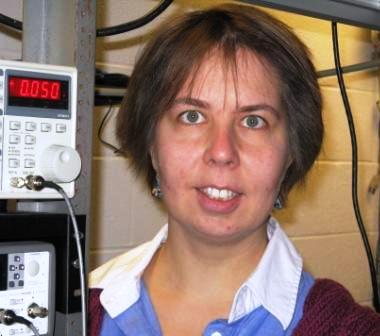 |
Irina Novikova Telephone: (757) 221-3693 FAX: (757) 221-3540 Office: Millington 249 Address: Department of Physics College of William&Mary P.O. Box 8795 Williamsburg, VA 23187-8795 Research group web-site |
(pdf)
Product news and updates - Training Workshops
- Featured Customer - Other News
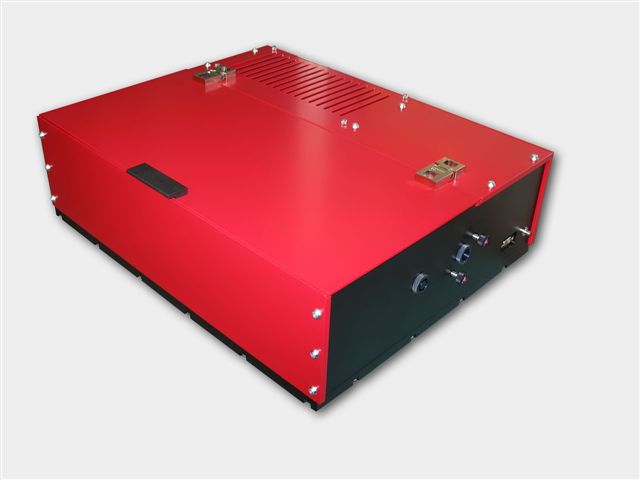 |
Trestles LH Ti:Sapphire
laser Trestles LH is a new series of high quality femtosecond Ti:Sapphire lasers for applications in scientific research, biological imaging, life sciences and precision material processing. Trestles LH includes integrated sealed, turn-key, cost-effective, diode-pumped solid-state (DPSS). Trestles LH lasers offer the most attractive pricing on the market combined with excellent performance and reliability. DPSS LH is a state-of-the-art laser designed for today’s applications. It combines superb performance and tremendous value for today’s market and has numerous advantages over all other DPSS lasers suitable for Ti:Sapphire pumping. Trestles LH can be customized to fit customer requirements and budget. Reserve a
spot in our Femtosecond lasers training
workshop in San Diego, California. Come to learn how to build a
femtosecond laser from a kit |
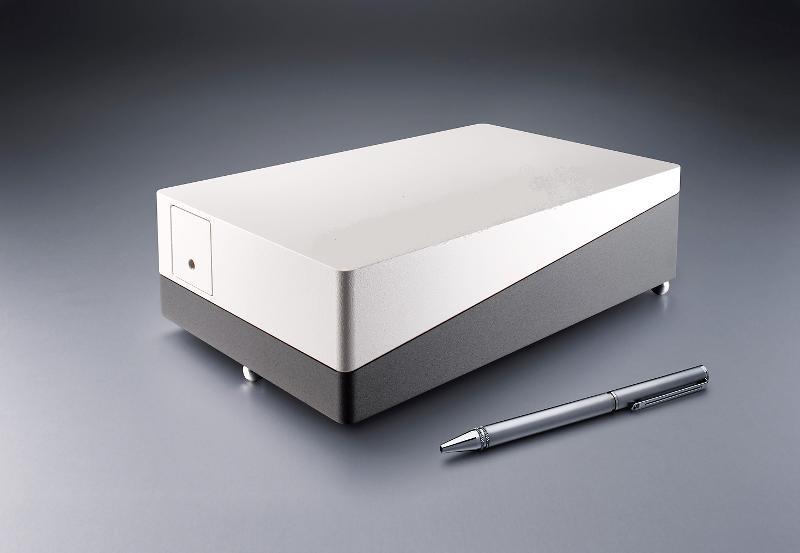 |
DPSS DMPLH lasers |
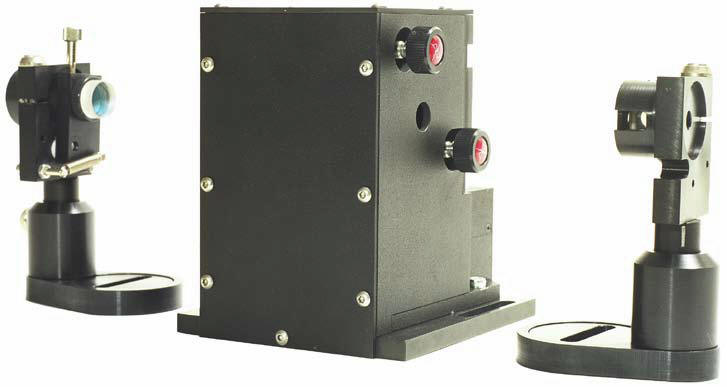 |
Pismo pulse picker The Pismo pulse picker systems is as a pulse gating system that lets single pulses or group of subsequent pulses from a femtosecond or picosecond pulse train pass through the system, and stops other radiation. The system is perfectly suitable for most commercial femtosecond oscillators and amplifiers. The system can pick either single pulses, shoot bursts (patterns of single pulses) or pick group of subsequent pulses (wider square-shaped HV pulse modification). HV pulse duration (i.e. gate open time) is 10 ns in the default Pismo 8/1 model, but can be customized from 3 to 1250 ns upon request or made variable. The frequency of the picked pulses starts with single shot to 1 kHz for the basic model, and goes up to 100 kHz for the most advanced one. The Pockels cell is supplied with a control unit that is capable of synching to the optical pulse train via a built-in photodetector unit, while electric trigger signal is also accepted. Two additional delay channels are available for synching of other equipment to the pulse picker operation. Moreover, USB connectivity and LabView-compatible drivers save a great deal of your time on storing and recalling presets, and setting up some automated experimental setups. One control unit is capable of driving of up to 3 Pockels cells, and this comes handy in complex setups or contrast-improving schemes. The system can also be modified to supply two HV pulses to one Pockels cell unit, making it a 2-channel pulse picker system. This may be essential for injection/ejection purposes when building a regenerative or multipass amplifier system. |
 |
New laser spectrometer
T&D-scan for research that
demands high resolution and high spectral
density in UV-VIS-NIR spectral domains - now available with
new pump option! The T&D-scan includes a CW ultra-wide-tunable narrow-line laser, high-precision wavelength meter, an electronic control unit driven through USB interface as well as a software package. Novel advanced design of the fundamental laser component implements efficient intra-cavity frequency doubling as well as provides a state-of-the-art combined ultra-wide-tunable Ti:Sapphire & Dye laser capable of covering together a super-broad spectral range between 275 and 1100 nm. Wavelength selection components as well as the position of the non-linear crystal are precisely tuned by a closed-loop control system, which incorporates highly accurate wavelength meter. Reserve a
spot in our CW lasers training
workshop in San Diego, California. Come to
learn how to build a
CW
Ti:Sapphire laser from a kit |
 |
Near IR viewers Ultraviolet viewers are designed to observe radiation emitted by UV sources. |
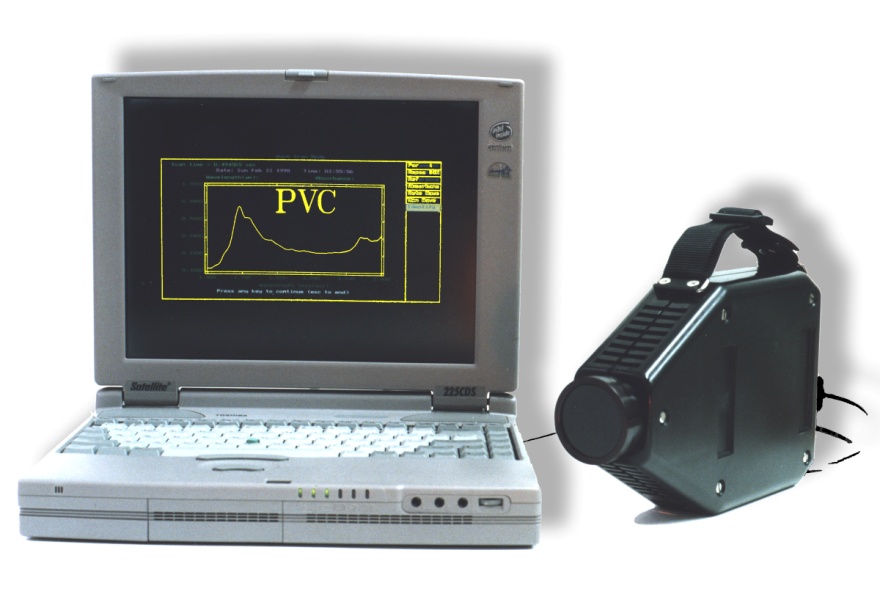 |
AOTF Infrared Spectrometer |
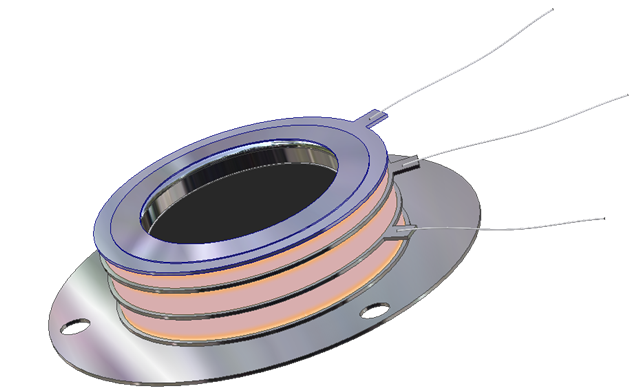 |
Open Microchannel Plate Detector
MCP-MA25/2 -
now in stock! |
 |
Hummingbird EMCCD camera The digital Hummingbird EMCCD camera combines high sensitivity, speed and high resolution. It uses Texas Instruments' 1MegaPixel Frame Transfer Impactron device which provides QE up to 65%. Hummingbird comes with a standard CameraLink output. It is the smallest and most rugged 1MP EMCCD camera in the world. It is ideally suited for any low imaging application such as hyperspectral imaging, X-ray imaging, Astronomy and low light surveillance. It is small, lightweight, low power and is therefore the ideal camera for OEM and integrators. buy online |
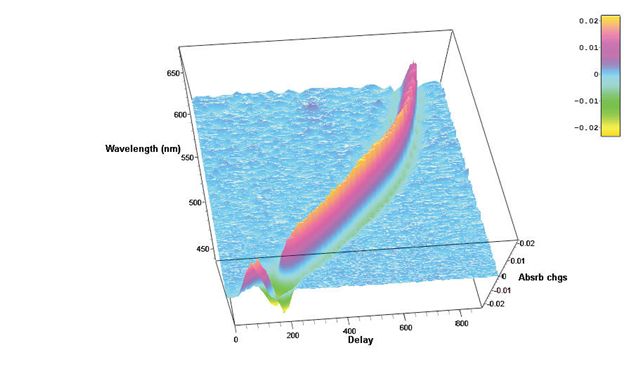 |
Hatteras-D
femtosecond transient absorption data acquisition system Future nanostructures and biological nanosystems will take advantage not only of the small dimensions of the objects but of the specific way of interaction between nano-objects. The interactions of building blocks within these nanosystems will be studied and optimized on the femtosecond time scale - says Sergey Egorov, President and CEO of Del Mar Photonics, Inc. Thus we put a lot of our efforts and resources into the development of new Ultrafast Dynamics Tools such as our Femtosecond Transient Absorption Measurements system Hatteras. Whether you want to create a new photovoltaic system that will efficiently convert photon energy in charge separation, or build a molecular complex that will dump photon energy into local heat to kill cancer cells, or create a new fluorescent probe for FRET microscopy, understanding of internal dynamics on femtosecond time scale is utterly important and requires advanced measurement techniques. Reserve a
spot in our Ultrafast Dynamics Tools
training workshop in San Diego, California. |
|
|
Beacon Femtosecond Optically Gated Fluorescence Kinetic Measurement System
-
request a quote -
pdf Reserve a
spot in our Ultrafast Dynamics Tools
training workshop in San Diego, California. |
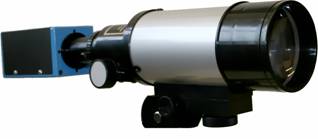 |
Wavefront Sensors: ShaH Family A family of ShaH wavefront sensors represents recent progress of Del Mar Photonics in Shack-Hartmann-based technology. The performance of Shack-Hartmann sensors greatly depends on the quality of the lenslet arrays used. Del Mar Photonics. developed a proprietary process of lenslet manufacturing, ensuring excellent quality of refractive lenslet arrays. The arrays can be AR coated on both sides without interfering with the micro-lens surface accuracy. Another advantage of the ShaH wavefront sensors is a highly optimized processing code. This makes possible real-time processing of the sensor data at the rate exceeding 1000 frames per second with a common PC. Due to utilizing low-level programming of the video GPU, it is possible to output the wavefront data with a resolution up to 512x512 pixels at a 500+ Hz frame rate. This mode is favorable for controlling modern LCOS wavefront correctors. The family of ShaH wavefront sensors includes several prototype models, starting from low-cost ShaH-0620 suitable for teaching laboratory to a high-end high-speed model, ShaH-03500. The latter utilizes a back-illuminated EM-gain CCD sensor with cooling down to -100°C. This makes it possible to apply such a wavefront sensor in astronomy, remote sensing, etc. |
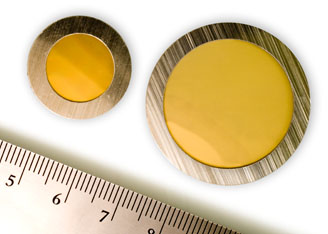 |
Terahertz systems, set ups and components New band pass and long pass THz optical filters based on porous silicon and metal mesh technologies. Band pass filters with center wavelengths from 30 THz into GHz range and transmissions up to 80% or better. Standard designs with clear aperture diameters from 12.5 to 37.5 mm. Long pass filters with standard rejection edge wavelengths from 60 THz into GHz range. Maximum transmission up to 80% or better, standard designs at 19.0 and 25.4 mm diameters. Excellent thermal (from cryogenic to 600 K) and mechanical properties THz products: THz Spectrometer kit with Antenna THz transmission setup THz time domain spectrometer Pacifica fs1060pca THz time domain spectrometer Pacifica fs780pca THz detectors: Golay cell and LiTaO3 piroelectric detectors PCA - Photoconductive Antenna as THz photomixer Pacifica THz Time Domain Spectrometer - Trestles Pacifica Holographic Fourier Transform Spectrometer for THz Region Wedge TiSapphire Multipass Amplifier System - THz pulses generation Terahertz Spectroscopic Radar Mobile System for Detection of Concealed Explosives Band pass filters with center wavelengths from 30 THz into GHz range Long pass filters with standard rejection edge wavelengths from 60 THz into GHz range Generation of THz radiation using lithium niobate Terahertz crystals (THz): ZnTe, GaAs, GaP, LiNbO3 - Wedge ZnTe |
 |
iPCA - interdigital Photoconductive Antenna for terahertz waves Large area broadband antenna with lens array and high emitter conversion efficiency iPCA with LT-GaAs absorber, microlens array for laser excitation wavelengths l £ 850 nm, adjusted hyperhemispherical silicon lens with a high power conversion efficiency of 0.2 mW THz power / W optical power. The iPCA can be used also as large area THz detector. The two types iPCAp and iPCAs have the same active interdigital antenna area but different contact pad directions with respect to the electrical THz field. Interdigital Photoconductive Antenna for terahertz waves generation using femtosecond Ti:Sapphire laser THz books |
 |
IntraStage lowers the cost
of test data management! Struggling with gigabytes or terabytes of test data? IntraStage easily transforms test data from disparate sources into web-based quality metrics and engineering intelligence you can use.
Contact
us today to discuss your test management requirements and specifications of your
application. |
Training Workshops
|
|
Come to San Diego next summer! Attend one of our training workshops in San Diego, California
during summer 2011 Del Mar Photonics has presented training workshops for customers and potential customers in the past 3 years. Our workshops cover scientific basics, technical details and provide generous time for hands-on training. Each workshop is a three-day seminar conducted by professional lecturer from 10am to 4pm. It includes lunch, as well as a training materials. We have also reserved two days for Q&A sessions, one-on-one system integration discussions, social networking, and San Diego sightseeing.
The following training workshops will be offered during this
summer: |
Featured Customer
|
|
Trestles LH10-fs/CW laser system at UC Santa Cruz Center of Nanoscale Optofluidics
Del
Mar Photonics offers new
Trestles fs/CW laser system which can be easily
switched from femtosecond mode to CW and back. Having both modes of operation in one system dramatically increase a
number of applications that the laser can be used for, and makes it an ideal
tool for scientific lab involved in multiple research projects. |
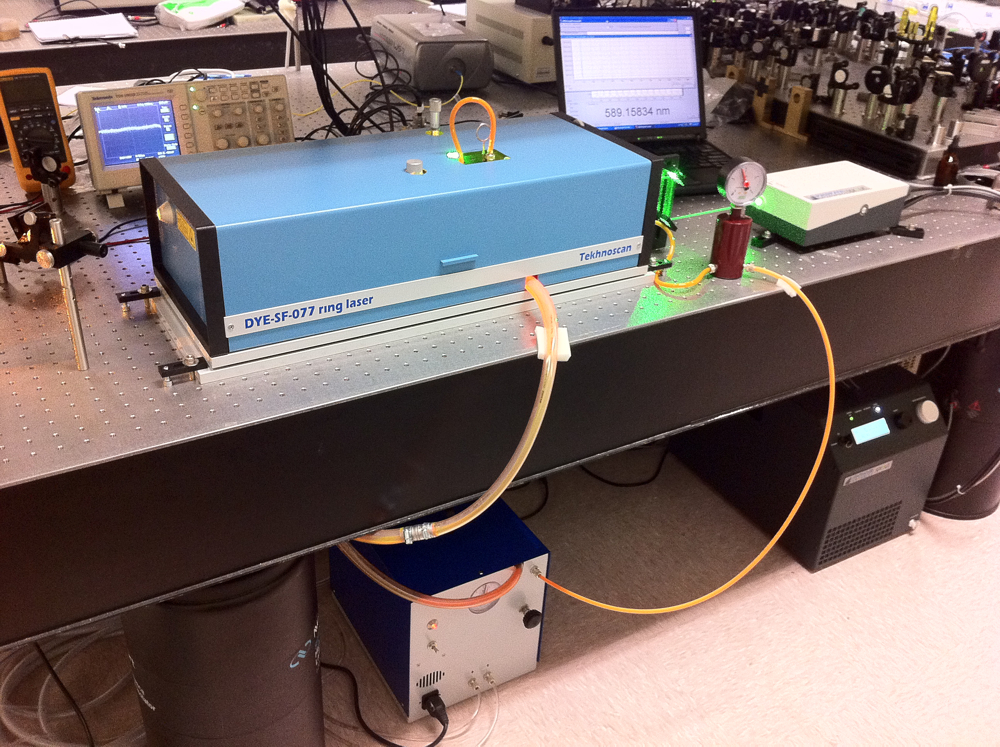 |
Frequency-stabilized CW single-frequency ring Dye laser DYE-SF-007 pumped by DPSS DMPLH laser installed in the brand new group of Dr. Dajun Wang at the The Chinese University of Hong Kong. DYE-SF-077 features exceptionally narrow generation line width, which amounts to less than 100 kHz. DYE-SF-077 sets new standard for generation line width of commercial lasers. Prior to this model, the narrowest line-width of commercial dye lasers was as broad as 500 kHz - 1 MHz. It is necessary to note that the 100-kHz line-width is achieved in DYE-SF-077 without the use of an acousto-optical modulator, which, as a rule, complicates the design and introduces additional losses. A specially designed ultra-fast PZT is used for efficient suppression of radiation frequency fluctuations in a broad frequency range. DYE-SF-077 will be used in resaerch of Ultracold polar molecules, Bose-Einstein condensate and quantum degenerate Fermi gas and High resolution spectroscopy |
Other News
Optical Society of Southern California meeting at UCSD OSSC 2011-04-27
Nd:YAG laser ordered by the University of Leon, UANL, Mexico
Wedge 50 Multipass Amplifier pumped with a Darwin-527-30-M DPSS Laser
ordered by Hong Kong customer
New
Trestles LH10-fs/CW femtosecond+CW laser ready for delivery to the
University of California Santa Cruz
Trestles femtosecond
Ti:Sapphire laser delivered to North Carolina State
University
Del Mar Photonics sponsor IONS (International OSA Network of Students)
conference IONS-NA-2 in Tucson, Arizona
IONS-NA-2
website
Best talk and best
poster awards at IONS-Moscow 2010 conference sponsored by Del Mar Photonics
Watch Del Mar Photonics
videos!
Del Mar Photonics is now on Twitter!
Del Mar Photonics featured components
Del Mar Photonics continuously expands its components portfolio.
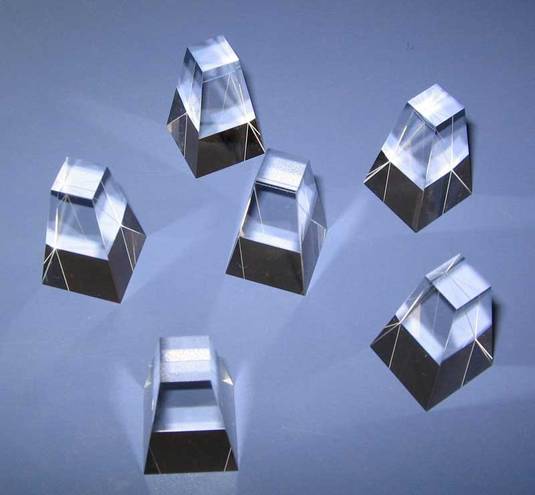 |
Solar
Prisms for Concentrating Photovoltaic Systems (CPV) Solar cells made of compound semiconductors such as gallium arsenide are very expensive. Usually very small cells are installed and various means such as mirrors, lenses, prisms, etc..are used to concentrate sunlight on the cells. Concentration photovoltaic technology (CPV) uses the solar radiation with an efficiency of 40%, double that of conventional solar cells Del Mar Photonics design custom Concentrating Photovoltaic Systems (CPV) and supply variety of the optical components for CPV such as solar prisms shown in the picture. |
|
|
Axicon Lens Axicon lens also known as conical lens or rotationally symmetric prism is widely used in different scientific research and application. Axicon can be used to convert a parallel laser beam into a ring, to create a non diffractive Bessel beam or to focus a parallel beam into long focus depth. Del Mar Photonics supplies axicons with cone angles range from 130° to 179.5° for use with virtually any laser radiation. We manufacture and supply axicons made from BK7 glass, fused silica and other materials. download brochure - request a quote |
 |
Rutile (TiO2) coupling
prisms Del Mar Photonics offers optical elements made of high quality synthetically grown Rutile Titanium Dioxide crystals. Rutile’s strong birefringency, wide transmission range and good mechanical properties make it suitable for fabrication of polarizing cubes, prisms and optical isolators. Boules having high optical transmission and homogeneity are grown by proprietary method. Typical boules have 10 - 15 mm in dia. and up to 25 mm length. Optical elements sizes - from 2 x 2 x 1 mm to 12.7 x 12.7 x 12.7 mm. Laser grade polish quality is available for finished elements. So far we the largest elements that we manufactured are 12 x15 x 5 mm, in which optical axis is parallel to 15 mm edge, 5 mm is along beam path, 12 x 15 mm faces polished 20/10 S/D, one wave flatness, parallelism < 3 arc.min. (better specs. available on request). more details - download brochure - request a quote |
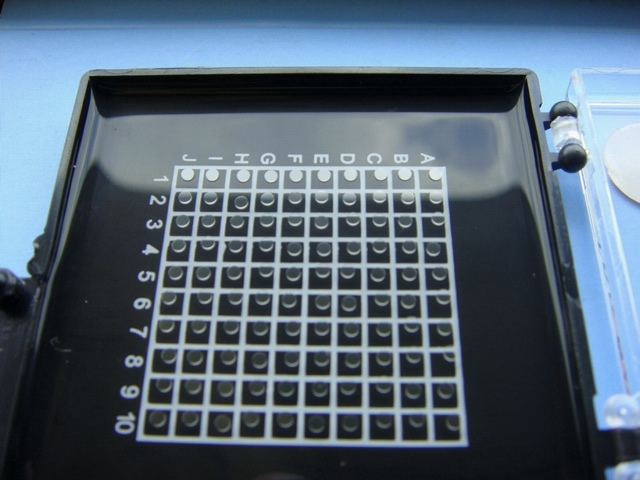 |
Sapphire components Sapphire Circular Windows - Square & Rectangle - Rods Sapphire & Ruby Rings - Sapphire & Ruby Balls - Sapphire & Ruby Nozzles Sapphire Lenses - Ball & Seat - Special Products - Sapphire Vee & Cup Jewels Sapphire Ceramics - Ceramic Sleeves - Ceramic Holes - Ceramic Rods Sapphire & Ruby Orifices - Sapphire & Ruby Tubes - Sapphire Components Sapphire Half Round Rod - Sapphire Windows - Rods & Tubes - Special Part Sapphire Prism - Sapphire Chisel - Sapphire Square Rod |
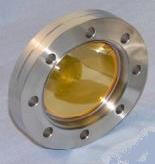 |
Vacuum viewport Del Mar Photonics offer a range of competitively priced UHV viewports , Conflat, ISO or KF including a variety of coatings to enhance performance. Del Mar Photonics viewports are manufactured using advanced techniques for control of special and critical processes, including 100 percent helium leak testing and x-ray measurements for metallization control. Windows Materials include: Fused silica, Quartz , Sapphire , MgF2, BaF2, CaF2, ZnSe, ZnS, Ge, Si, Pyrex. Standard Viewing diameters from .55" to 1.94 ". Coating - a range of custom coatings can applied - which include - Single QWOT - Broad Band AR - V coatings - ITO - DLC (Diamond like coating) more details - request a quote |

|
Hydrogen
Thyratrons are used in
such devices as radars with different power levels, high-power pulsed
technical, electrophysical, medical devices and lasers. Sophisticated
design and high quality ceramic-metal envelope determines long lifetime
and very accurate and reliable operation of hydrogen thyratrons under wide range of environmental
conditions. Applications: - radars - pulsed lasers power supplies - medical apparatus - electrophysical instrumentation Triggered Three-Electrode Spark Gap Switches are ceramic-metal sealed off gas discharge trigatron-type devices with a co-axial trigger electrode. These Gas Discharge Tubes contain no mercury and, due to an advanced design, feature high reliability and a long lifetime being operating under wide range of environmental conditions. Applications: - pulsed installation for processing materials - installations with plasma focus - pulse power supplies for lasers and other pulse equipment - medical apparatus such as lithotriptors and defibrillators - processing systems for petroleum wells |
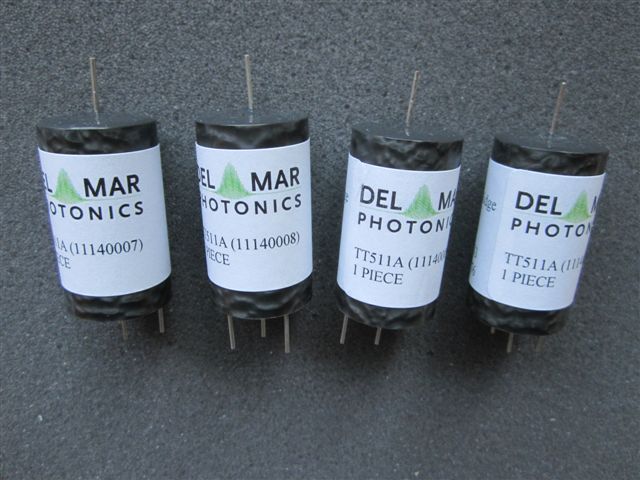 |
Trigger Transformers Del Mar Photonics supply trigger transformers for triggered spark gaps and other applications. Contact us to today to discuss your application or requesta quote. Trigger Transformers are used to provide a fast high voltage pulse up to 30kV/µs and more. This high voltage pulse is applied to the trigger electrode to initiate switching action in the three-electrode spark gaps. Either positive or negative pulses can be obtained from all of the transformers.
|
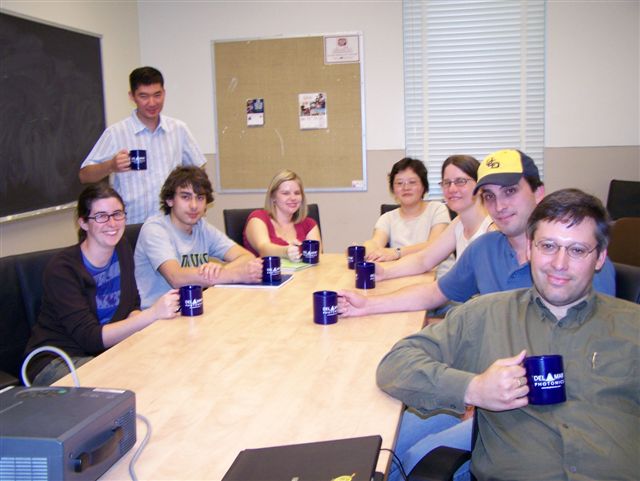 |
We are looking forward to hear from you and help you with your optical and crystal components requirements. Need time to think about it? Drop us a line and we'll send you beautiful Del Mar Photonics mug (or two) so you can have a tea party with your colleagues and discuss your potential needs. |
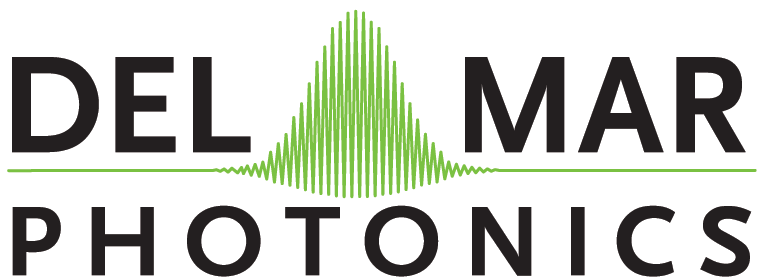
Del Mar Photonics, Inc.
4119 Twilight Ridge
San Diego, CA 92130
tel: (858) 876-3133
fax: (858) 630-2376
Skype: delmarphotonics
sales@dmphotonics.com